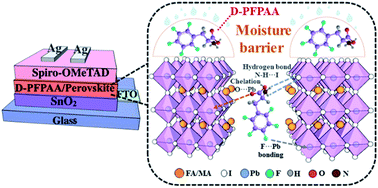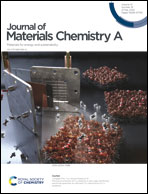Consolidating a Pb–X framework via multifunctional passivation with fluorinated zwitterions for efficient and stable perovskite solar cells†
Abstract
Ionic defects in perovskite films decrease both the power conversion efficiency (PCE) and stability of a perovskite solar cell (PSC). Herein, fluorinated D-pentafluoro-phenylalanine (D-PFPAA) zwitterions are introduced into a perovskite to passivate the ionic defects and effectively consolidate the Pb–X framework to suppress ion migration. The results demonstrate that the amino, carboxyl, and fluorine groups in D-PFPAA can support the multifunctional passivation of both positive and negative ionic defects, including uncoordinated Pb2+ ions and halogen (X−) defects in the perovskites, thereby effectively suppressing charge recombination. Consequently, a D-PFPAA-modified device shows a highest PCE of 21.56% with an increased open circuit voltage of 1.15 V. Apart from the consolidated Pb–X framework, resulting from multifunctional passivation, the fluorine groups in D-PFPAA can also form an effective hydrophobic barrier to protect the perovskite film from moisture-related erosion. As a consequence, the D-PFPAA-modified device retains more than 85% of its original PCE after undergoing 500 h of aging at 45% relative humidity under ambient conditions. This work provides a promising strategy for the realization of efficient and stable PSCs via the selection of fluorinated zwitterions to passivate the ionic defects, inhibit ion migration, and protect against moisture damage.



 Please wait while we load your content...
Please wait while we load your content...